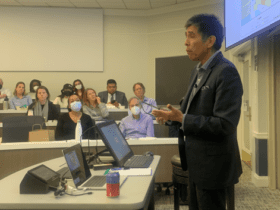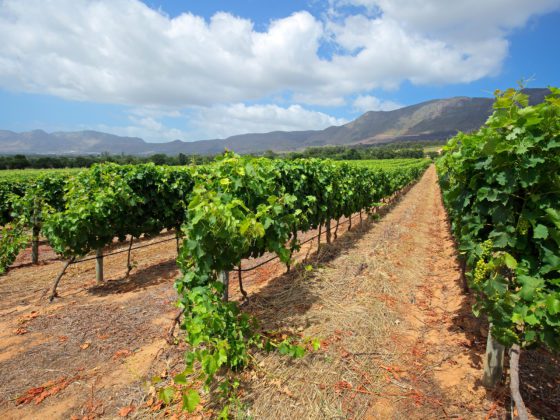Have you wondered whether recent flooding in Charlottesville or Japan has anything to do with climate change? I am not really wondering. I get a sinking feeling every time I hear about another instance of torrential rain with catastrophic effects. Instead of questioning whether climate change caused two drownings in Charlottesville this May or the death and devastation resulting from mudslides in Japan, I think: this is our new reality. More of this is coming. Recent extreme rainfall events are yet another signal that climate change is happening. Torrential rain is exactly what we predict with a warming planet.
Extreme climate events, like those that produce flooding, are one way to translate global warming of one, two or three degrees Celsius into something more tangible. Another way is to decode the day to day conditions produced by changes in the ‘average’ climate. Exploring the lived experience on the ground means focusing in on a particular place. My research group is taking both approaches. We are studying the impacts of climate change in the Great Lakes Region of East Africa. The area is home to chimpanzees, mountain gorillas and charismatic fauna of the savanna, the highest peak in Africa, the second largest lake in the world, and over 230 million people in 10 countries.
With support from the MacArthur Foundation and the Global Research Program of Distinction at the University of Virginia, we recently finished a study of exposure to heat stress in the latter half of the century.[1] We show that climate change and population growth could cause tens of millions of people to experience months and months of dangerous heat. Imagining that world is difficult, but largescale migration seems inevitable. How could people possibly stay under such conditions? Adaptation strategies exist, such as early warning systems, heat-mitigating architecture, and expanding access to air conditioning. More natural air conditioners, like shade trees in the cities, large tracts of forest and healthy wetlands in the country, may also help. Successful adaptation, however, is contingent on adequate finance and good governance. At present, many countries in the Great Lakes Region lack both.
Now, with additional support from the Global Water Initiative at UVa, we have embarked on a study of extreme rainfall in the region. Our team includes Anton Seimon at Appalachian State University, Peter Lawrence and James Pinto at the National Center for Atmospheric Research, Salvi Asefi-Najafabady and Karen Vandecar, both affiliated with UVa, Tracy Baker at The Nature Conservancy and Simon Nampindo of Wildlife Conservation Society. We are part of a larger project, led by Seimon and funded by the MacArthur Foundation, that includes specialists in wildlife conservation, lake ecology and disease both from the US and the region.
Our first investigation, led by Asefi-Najafabady and Baker, focuses on where water will be stored in a warmer climate: will it be in the soil—ready to support crops; in the Great Lakes themselves—sustaining the most diverse freshwater fisheries on the planet; or in the rivers—where water might overtop their banks? We are interested in whether water resources will be adequate for critical human uses and for sustaining the ecosystems on which we depend. Fundamentally, we are asking: Will there be enough water? Will there be too much water? And how will these outcomes vary across the region?
Preliminary results from an in depth study of the Lake Tanganyika basin suggest modest increases in rainfall with climate change, but only a small increase in the amount stored and ‘useful’ to people. (More on the technical details can be found in this Q&A on the water blog from July.) The water that will fill rivers, keep lake levels high and recharge aquifers only increases a fraction of a percent. Fortunately, some of the additional rainfall is stored as increased soil moisture, where it will be available to promote crop growth and ecosystem health. Additionally, some will be transferred to the atmosphere in enhanced evapotranspiration (water loss through holes in the underside of leaves—the plant version of sweating). Evapotranspiration is the natural air conditioner mentioned above.
In just about any scenario, the human population of the Great Lakes region will increase. Because the increase in regional rainfall is anticipated to be modest, and because it results in a very minor increase in stored water, per capita water availability is likely to decline by 2050. By one index (the Water Crowding Index, or WCI), Asefi-Najafabady and Baker estimate that three million people in the Lake Tanganyika basin currently experience water scarcity. By 2050, that number could double.
Water supply is not the only worry. Extreme rainfall events deliver large amounts of rainfall in a short period of time, sometimes so fast that it cannot be absorbed by the soil. When that happens, surface run-off carries loose dirt, debris and pollutants to rivers and lakes. Our preliminary study suggests that surface run-off will increase by midcentury across the Lake Tanganyika basin and that the sediment carried along with it will increase substantially. At best, freshwater supplies would be unsuitable for humans from time to time. At worst, the waters would fail to support a full array of aquatic life and would not be safe for humans. Increased sediment indicates potential problems downstream for essential fisheries, as well as potential problems upstream, where run-off leads to erosion of nutrient-rich topsoil from farms.
When run-off exceeds the capacity of rivers, flooding occurs. Our model does not provide a direct index of flooding, but it does predict river discharge which is related to flood risk. In many parts of the basin, annual river discharge is likely to increase. A question we are still exploring with the model is whether that increase will come from a greater frequency of dangerous, high peak flows as a result of more extreme rainfall events. The physics of a warmer atmosphere dictate that such extreme events should indeed be more frequent. Simply because it holds more water vapor (think of the humidity in July versus January), a warmer atmosphere has more water to deliver in any one storm. Most climate models predict an increase in extreme rainfall events for the Great Lakes region [2]and indeed for much of the world.[3]
I am heartened to learn that parts of the Great Lakes region will get more rainfall in a warmer future, because dealing with heat stress is easier when it is not compounded by drought. Unfortunately, as our study of the Lake Tanganyika basin shows, more rainfall does not translate directly into more “useful” water – not for us or for the ecosystems on which we rely. What we will have more of is heavy, heavy rains. And we have already seen what they can do.
Deborah Lawrence is a Professor of Environmental Sciences at the University of Virginia who focuses in her research on climate change.
[1] Salvi Asefi-Najafabady, Karen L Vandecar, Anton Seimon, Peter Lawrence, and Deborah Lawrence. 2018. Climate change, population and poverty: vulnerability and exposure to heat stress in countries bordering the Great Lakes of Africa. Climatic Change 148: 561. https://doi.org/10.1007/s10584-018-2211-5
[2]Shongwe, Mxolisi E., Geert Jan Van Oldenborgh, Bart Van Den Hurk, and Maarten Van Aalst. 2011. Projected Changes in Mean and Extreme Precipitation in Africa under Global Warming. Part II: East Africa. Journal of Climate 24:3718-3733. DOI: 10.1175/2010JCLI2883.1
[3] S. Pfahl, P. A. O’Gorman and E. M. Fischer. 2018. Understanding the regional pattern of projected future changes in extreme precipitation. Nature Climate Change 7: 423–427.


(photos provided by Anton Seimon)





